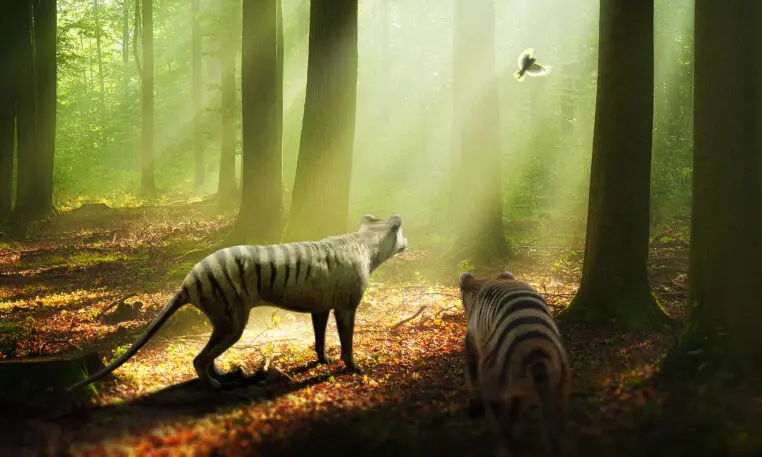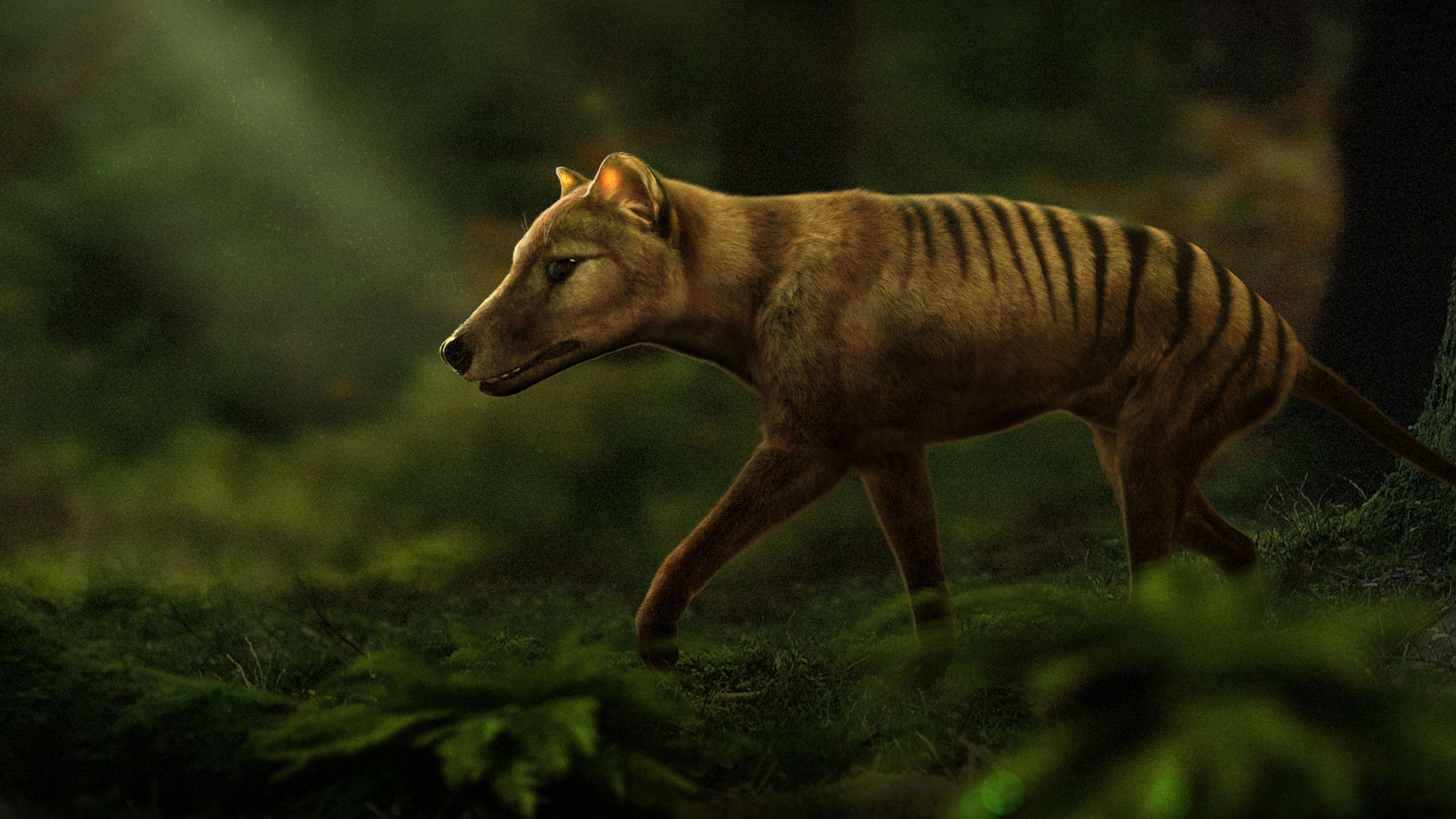By the 1920s, Yellowstone employees had exterminated all of the national park’s gray wolves, as directed by federal and state control programs. But in 1995, the wolves were reintroduced, and the apex predator has since reenergized the park’s ecosystems, producing positive effects that cascade down the food chain.
To avoid the preying wolves, the elk keep on the move, meaning they eat fewer of the young willow and aspen trees. With fewer elk eating young trees, that vegetation has since regenerated, creating habitats for beavers and songbirds. Elk carrion has provided food for scavengers like coyotes and eagles. And even river structure has improved, with the new, rich forests stabilizing the banks and reducing erosion.
Reintroducing a species that still exists is relatively easy. The same can’t be said for the thylacine (also known as the Tasmanian tiger for its vivid stripes), an Australian apex predator that went extinct in 1936 due to overhunting.
The marsupial’s disappearance has fundamentally altered Tasmanian ecosystems via trophic downgrading, whereby removing the organism atop a food chain alters the entire community structure and biodiversity below it. To restore them, scientists want to bring the thylacine back to life.
De-extinction company Colossal Biosciences announced it’s in the process of doing just that using gene-editing technology, just as it’s working on “de-extincting” the woolly mammoth in the Arctic. The company also says the tech could help rebound the populations of currently existing marsupials. But despite those benefits, experts have some biological—and ethical—concerns.
“The Tasmanian tiger is an incredible animal,” says Andrew Pask, a professor at the University of Melbourne who’s been studying the possible rewilding of the thylacine under his Thylacine Integrated Genomic Restoration Research (TIGRR) Lab, and who is leading Colossal’s thylacine project.
The animal wasn’t technically a tiger, but rather a marsupial, and the only apex predator in that animal group; Pask describes it as having an “incredible body form” with tiger-like stripes, the appearance of a wolf, and a pouch like a kangaroo. But this keystone species, one that’s essential to the whole diverse ecosystem of Tasmania, from its grazable grasslands to its eucalyptus forests, has no natural replacements.
“When you lose those apex predators, it throws that entire ecosystem beneath it completely out of balance,” Pask says.

But first they’d have to bring the creature back to life using genetic engineering. Colossal aims to identify the relevant DNA from its closest genetic relatives, edit the genes, and assemble the genome for the new proxy, or the end result that wouldn’t be fully a thylacine, but “the best version of that animal that’s possible,” Pask says.
Scientists would then create the embryo, and birth the joey using one of two methods: in the lab via an artificial womb or with a surrogate mother.
The latter method is what they’re employing for the mammoth, whereby an elephant will be a surrogate. In the thylacine’s case, they’ve identified the fat-tailed dunnart, a tiny, mouse-size marsupial just 3 inches in length, as a potential surrogate. Because all marsupials give birth to tiny, underdeveloped babies—often the size of a grain of rice—which they then nurse in a pouch, “It’s quite possible that a little mouse-size dunnart could give birth to a baby thylacine,” Pask says.
Besides bringing back an extinct animal, Colossal says the benefit of the project is that the technology it develops could translate into the conservation of existing but threatened marsupials. By building artificial wombs, the company could increase the litter sizes of Tasmanian devils, for example.
Similarly, numbers of the northern quoll, a spotted, cat-size marsupial, have recently declined because they’ve been feeding on cane toads—an invasive species that was introduced to control pest beetles in Queensland’s sugar cane fields, to disastrous effect—and are dying from the toxins on the toads’ skin. Colossal could potentially edit the quoll’s genome to make it resistant to the poison, allowing it to keep preying on the toads, thus culling the invading amphibians.

There are also possibilities for unintended effects, like the proxy introducing new diseases into the community. Separately, Victoria Herridge, a paleontologist at the Natural History Museum in London who turned down a consultancy role for Colossal, wrote last year that for a technology with such broad consequences across the world, the general public should have a say. “Let the people decide the future world they want to build,” she wrote.
Commenting generally, and not on the specific thylacine case, Ronald Sandler, a professor of philosophy and director of the Ethics Institute at Northeastern University who focuses on environmental ethics, says he’s not against de-extinction, but emphasizes the importance of considering the most effective ways of tackling conservation challenges. Perhaps such an “elaborate technological solution” could be a distraction that does not address the underlying problems.
“The ecological and biodiversity crisis that we have right now isn’t that there are no mammoths,” Sandler says. A strategy to address those crises would have to be at large scale, and happen fast, as the climate crisis rapidly progresses. What’s more, a nostalgic solution may not be compatible with an ecological future that doesn’t resemble the past.
“To what extent is bringing something back the right response,” he asks, “rather than taking a more forward-looking approach to allow ecological systems to reconfigure, and to make the conditions appropriate for them to be able to do that.”
As for the timeline, Ben Lamm, founder and CEO of Colossal, says there’s no planned date for reintroduction, but he says since all the main technology is already available, the company doesn’t have to wait for any “magic breakthroughs.” Besides, marsupials have short gestation periods of days and weeks, versus 22 months for elephants, so the thylacines could be the first animal it brings back.
In total, Colossal estimates bringing back 10,000 thylacines, and would likely look into “mass production” (how to breed hundreds or thousands at a time) rather than wait a long while for natural breeding.
The team says they’ll be careful about the reintroduction, not releasing the thylacines into the wild right away but first studying them in big enclosures. They’re already working with conservation nonprofits, bioethicists, and local governments, and plan to involve communities including Indigenous people in the Arctic Circle and Aboriginal groups in Australia. “Our goal is not buy-in, but collaboration throughout the entire project,” Lamm says.
Ultimately, faced with the prospect of losing half the world’s biodiversity by 2050, the team at Colossal feels an urgency to intervene.
“Our entire Earth falls apart without these species,” Lamm says. “If we lose 50% of biodiversity between now and 2050, we all die.” They view de-extinction as just another tool in the conservation toolbox.
“Animals cannot evolve quickly enough to keep up with how rapidly we’re changing the planet,” Pask says. “If we’ve got these gene-editing technologies, we can help animals keep up.”
Recognize your brand’s excellence by applying to this year’s Brands That Matter Awards before the early-rate deadline, May 3.
